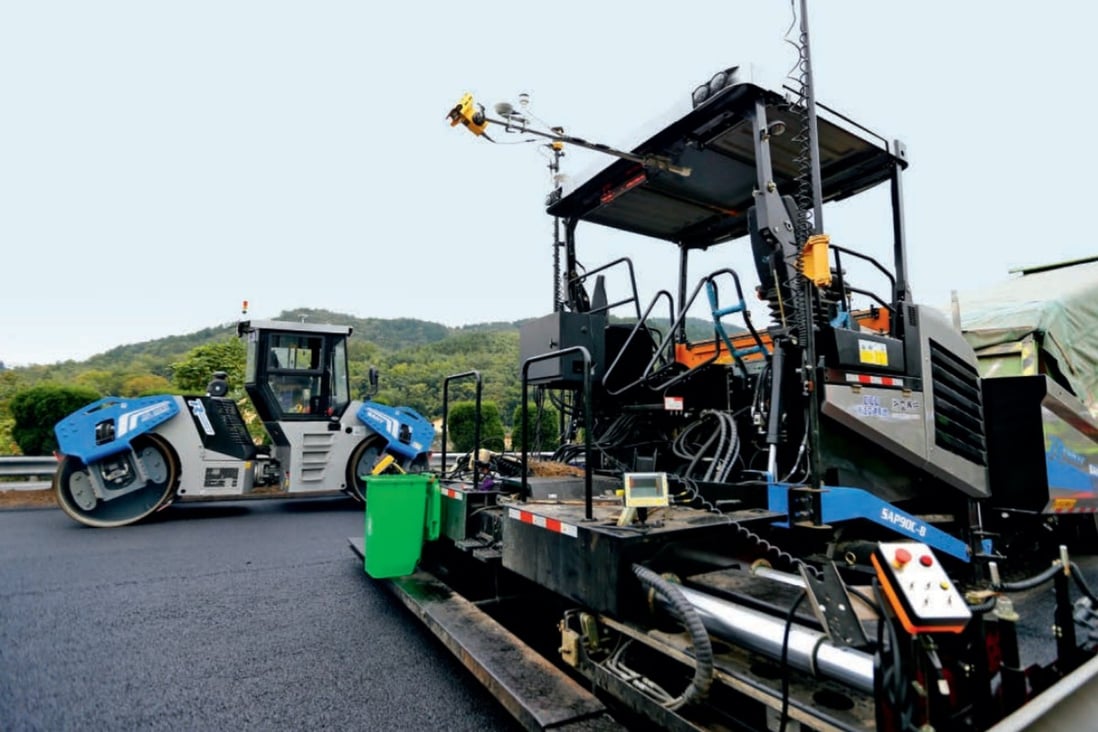China’s army of robotic rollers paving a road to future infrastructure
- Major infrastructure projects in China increasingly feature a growing workforce of construction robots
- They include autonomous rollers that can navigate construction sites and learn to improve their own performance
Some of the largest
projects under construction in China have started using robots.The projects include the world’s most challenging water diversion project, its tallest dam, a
, and part of an expressway that the mainland Chinese government hopes will link Beijing to Taipei.However, driven by disruptive technology such as
, huge investment in infrastructure and rising labour costs, a small but rapidly expanding army of construction robots has emerged in China.The use of robots is transforming China’s construction sector “from a labour-intensive industry to a knowledge-based hi-tech industry”, said Yan Junle, a senior civil engineer on the Hanjiang-to-Weihe river valley water diversion project, in a paper published this month in domestic journal Construction Machinery Technology and Management.
Yan’s team were the first users of construction robots in a major Chinese infrastructure project. In 2018, they built a fleet of autonomous rollers in collaboration with researchers from Tsinghua University and funding from the government.
The Han-Wei water diversion project was designed to channel 1.5 billion cubic metres (400 billion gallons) of water a year from the Yangtze River region to the thirsty Yellow River region in the northwestern province of Shaanxi – the starting point of the
on land.The project involved two enormous dams and a 100km (62-mile) water tunnel through the Qinling Mountains. Without the robotic rollers, the project team would have struggled to complete the construction by their deadline this year, according to Yan.
A human driver would have to take frequent breaks because “the rollers generate strong vibrations that could cause damage to health”, Yan and colleagues said in the paper. The robots improved construction quality, too, they said.
“Traditional rolling by humans cannot obtain construction data, and there are many problems such as uneven compression, underpressure, overpressure … that severely threaten quality,” they wrote.
Other infrastructure project teams, such as those building new dams in Tibet and the Xiongan “city of the future” south of Beijing, adopted similar technology.
They encountered some problems. A construction site can be quite complex, especially when using more rollers, according to research papers published by scientists involved in these projects. Some working areas, for instance, were irregular shapes, and had obstacles that had to be avoided.
Planning and coordinating movements could pose challenges to the AI technology, while communication devices often broke down in cold, high-altitude areas such as Tibet.
Despite such challenges, the Shuangjiangkou hydropower project on Dadu river in Sichuan took the use of robots to a new level. The 20 billion yuan (US$3 billion) dam should be 312 metres (1,024 feet) high when it is completed in 2024.
Unlike the Han-Wei water diversion project, which used the US-developed Global Positioning System, and microwave radio for communication, the robots working on Shuangjiangkou dam used China’s new
and newcommunication technology.The smart rollers were linked to sensors placed around the construction site, and are equipped to learn from the data collected how to improve their performance. Drones, meanwhile, were used to detect potential environmental hazards.
These smart machines were linked to a central computer armed with AI technology to coordinate the interactions between humans and machines, according to information on the Sichuan provincial government website.
Last year, transport authorities in Zhejiang province approved the first use of robots in road maintenance.
Whereas most construction robots so far have been rollers, maintainer robots on the proposed Beijing-Taipei road can manage a wider range of tasks, such as paving a road with asphalt.
The authorities concluded that the machines would help solve a labour shortage, improve work precision by 50 per cent, reduce time by a quarter and cut costs by 15 per cent.
A private contractor on a government infrastructure project in Guangdong said robots had become a buzzword. They may look clumsy, he said, but they could revolutionise their industry “just like the early steam locomotives”.
“I will do anything to replace workers with machines,” he said, requesting not to be named because of the sensitivity of the issue.
Most young people do not want to work on construction sites, he said, adding that skills varied from one person to another. “Robots are good for quality control,” he said.
Some experts have warned that increased use of robots could have a negative impact on society.
A study led by the University of Nottingham Ningbo China this month found that use of robots did not help boost incomes as much as expected, and did not increase overall productivity.
Another study published this month by Guangdong University of Technology researchers found that in the Pearl River Delta, one of China’s most industrialised regions, the transition from human labour to robots had increased unemployment and reduced workers’ average pay.
Large-scale application of robots can “stimulate economic growth but destroy employment”, the researchers said.






































SCMP Editorials
Opinion
Harry's View
Letters